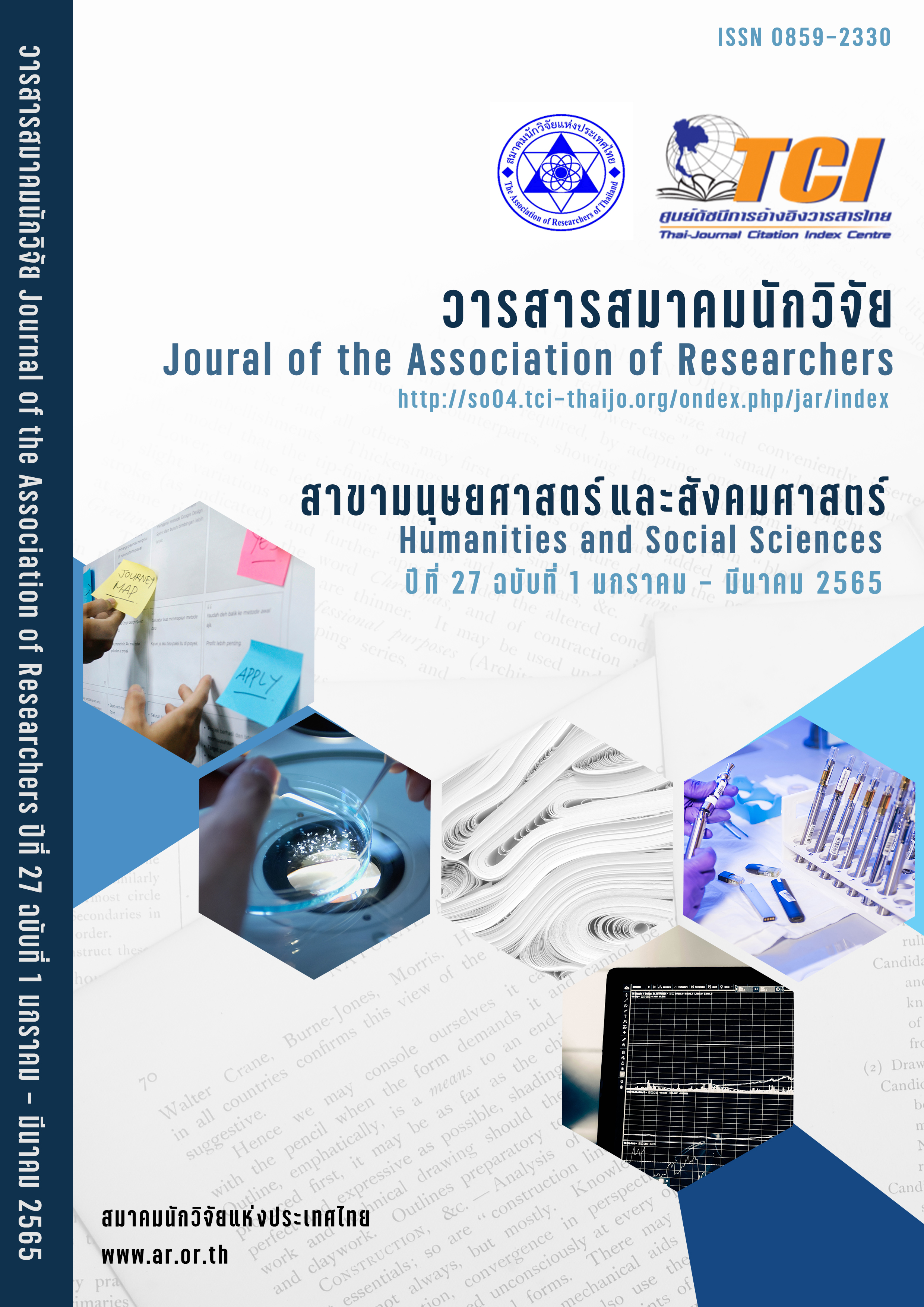The Development and the Promotion of Chiangrai Tourism to Become a Secondary City Destination
Main Article Content
Abstract
This research article have a purpose 1. To study the tourism resources of Chiang Rai 2. To find a way to use the tourism resources of Chiang Rai in the development of various types of tourism in Chiang Rai. 3. To create guidelines for the development of elements of tourism in Chiang Rai Qualitative research was conducted in-depth interviews with 24 key informants involved in Chiang Rai tourism. It consists of government personnel in both the central and provincial governments, the private sector, both the Chamber of Commerce and entrepreneurs. Community and academic sectors in Chiang Rai Province It was found that Chiang Rai Province is a province that has potential to be a secondary city that is a target tourism city. Chiang Rai is a border city with easy borders with Laos, China and Burma. It is a city that has been declared a special economic zone. It is a city with a variety of tourism resources that can develop many types of tourism. There are two national artists of fine arts in Chiang Rai and there are artists who create works of art for tourists to appreciate the fine arts and architecture of various temples, especially Wat Rong Khun. For the components of tourism development. Chiang Rai is ready in almost every way except for the mass transit services that serve tourists to travel to see the attractions of Chiang Rai. As for tourism promotion, there are still many things that need to be improved especially. Marketing communications in Chiang Rai's branding and products/services will require a campaign to get more communities involved and develop them into Chiang Rai's ambassadors to help promote Chiang Rai and behave as a Great hosts to welcome tourists.
Article Details

This work is licensed under a Creative Commons Attribution-NonCommercial-NoDerivatives 4.0 International License.
บทความที่ปรากฏในวารสารนี้ เป็นความรับผิดชอบของผู้เขียน ซึ่งสมาคมนักวิจัยไม่จำเป็นต้องเห็นด้วยเสมอไป การนำเสนอผลงานวิจัยและบทความในวารสารนี้ไปเผยแพร่สามารถกระทำได้ โดยระบุแหล่งอ้างอิงจาก "วารสารสมาคมนักวิจัย"
References
สำนักงานปลัดกระทรวงการท่องเที่ยวและกีฬา.
กฤษฎา รัตนพฤกษ์, (2562) “จุดกระแสเมืองรองท่องเที่ยวเชิงวัฒนธรรมไทย-อาเซียน ผ่านงานศิลปะ”19 ก.ย. 2562
17:23 น. การท่องเที่ยวแห่งประเทศไทย
จิตคุปต์ ละอองปลิว, (2562)การท่องเที่ยวเมืองรอง : ทางเลือกแหล่งท่องเที่ยวเชิงสร้างสรรค์ จังหวัดราชบุรี ปีที่ 14 ฉบับที่ 2:39-60 อินทนิลทักษิณสาร มหาวิทยาลัยทักษิณ
นพดล ภาคพรต (2562). “55 เมืองรอง” เติบโตทุกมิติ ททท.เร่งสร้างแบรนด์กระตุ้นรายจังหวัด วันที่ 16 สิงหาคม 2561 –
07:00 น. ประชาชาติธุรกิจ
บุษบา สิทธิการ และสิริวัฒนา ใจมา, (2552)การพัฒนาบทบาทองค์การปกครองส่วนท้องถิ่นในการส่งเสริมและสนับสนุนความ
พร้อมของเสนอทางเชื่อมโยงแหล่งท่องเที่ยวโดยชุมชน ในกลุ่มภาคเหนือตอนบนของประเทศไทย. มหาวิทยาลัย
แม่ฟ้าหลวง.สำนักงานคณะกรรมการวิจัยแห่งชาติ. กรุงเทพ. 231 น.รําไพพรรณ แก้วสุริยะ. 2542. เกษตรสัญจร.
จุลสารการท่องเที่ยว
บุญเลิศ จิตตั้งวัฒนา (2548). การพัฒนาการท่องเที่ยวแบบยั่งยืน. กรุงเทพฯ: เพรส แอดน์ดีไซน์.
บุญเลิศ จิตตั้งวัฒนา (2549) การพัฒนาและการอนุรักษ์แหล่งท่องเที่ยว = Tourism Resources Development and Reservation /กรุงเทพฯ : เพรส แอนด์ ดีไซน์,
ปาริฉัตร สิงห์ศักดิ์ตระกูล และพัชรินทร์ เสริมการดี. (2556)การศึกษาศักยภาพและแนวทางการพัฒนาการท่องเที่ยวเชิงอนุรักษ์
ของชุมชนบ้านทุ่งมะปรัง อำเภอควนโดนและบ้านโตนปาหนัน อำเภอควนกาหลง จังหวัดสตูล.วารสารสุทธิปริทัศน์, 27(83): 97-112.
ปิยพงศ์ เขตปิยรัตน์,ภาศิริ เขตปิยรัตน์,วัชราภรณ์ อารีรัตนศักดิ์,อมรรัตน์ ศรีวิโรจน์,มานะศิลป์ ศรทนงค์,และเชียง เภาชิต, (2561) กระบวนการสื่อสารการตลาดที่ส่งผลต่อภาพลักษณ์การท่องเที่ยวเชิงเกษตรในจังหวัดอุตรดิตถ์วารสารวิชาการการท่องเที่ยวไทยนานาชาติปีที่ 14 ฉบับที่ 1 มกราคม-มิถุนายน 2561
วิภา ศรีระทุ. (2551). ศักยภาพแหล่งท่องเที่ยวเชิงนิเวศน์ในอำเภอเขาค้อ จังหวัดเพชรบูรณ์.สารนิพนธ์ วท.ม. (การวางแผน
และการจัดการการท่องเที่ยวเพื่ออนุรักษ์สิ่งแวดล้อม).กรุงเทพฯ: บัณฑิตวิทยาลัย มหาวิทยาลัยศรีนครินทรวิโรฒ.
วิศรุต อินแหยม, (2562) “เมืองรองต้องลอง”การท่องเที่ยวแห่งประเทศไทย9 พ.ค.2562 09.20 น.
พยอม ธรรมบุตร แนวทางพัฒนาแบรนด์ท่องเที่ยวเชิงวัฒนธรรม 4.0 วารสารวิชาการ ปีที่13 ฉบับที่2 พฤษภาคม – สิงหาคม 2562มหาวิทยาลัยราชภัฏศรีสะเกษ Sisaket Rajabhat University Journal
ยุทธศักดิ์ สุภสร, (2562)“เมืองรอง ดึงอัตลักษณ์ท้องถิ่น เชื่อมท่องเที่ยววัฒนธรรมไทย-อาเซียน”การท่องเที่ยวแห่งประเทศไทย 25 ก.ย. 2562 08:52น.
ศรัณพร ชวนเกริกกุล, (2561) กลยุทธ์การยกระดับการตลาดท่องเที่ยวเชิงวัฒนธรรมเมืองรองจังหวัดสิงห์บุรี. กรุงเทพฯ: บัณฑิตวิทยาลัย มหาวิทยาลัยสยาม.
สมจินต์ ชาญกระบี่ และนรินทร์ สังข์รักษา, (2560) ยุทธศาสตร์การท่องเที่ยวเชิงสร้างสรรค์ของจังหวัดสุพรรณบุรี. Veridian E-Journal. 10(2), 2410-2425.
อาทิตยาพร ประสานพานิช (2018). แนวทางการพัฒนาส่วนประสมทางการตลาดออนไลน์ของโรงแรมในเขตพัฒนาเศรษฐกิจ
พิเศษ ภาคตะวันออกเฉียงเหนือ.วารสารวิชาการบริหารธุรกิจ ISSN : 2287-0717 ปีที่ 7 ฉบับที่ 2 กรกฎาคม - ธันวาคม
2561 Vol.7 No.2 July - December
Kotler, Philip.(2000). Marketing Management. The Millennium edition.New Jersey: Prentic – Hall.
Hosany, S., Ekinci, Y. & Uysal, M. (2007). Destination Image and Destination Personality. International Journal of Culture, Tourism and Hospitality Research, 1 (1), 62-81.
Kotler, P. (2003). Marketing Management. 11th ed. Upper Saddle River. HJ: Prentice-Hall.
Pickton, D. & Bodderick, A. (2005). Integrated marketing communications 2 nd ed. Harlow: Prentice Hall.
Rudez, Helena. Nemec. (2014). Affective tourism destination image: the case of PORTOROŽ. Tourism and Hospitality Industry. CONGRESS PROCEEDINGS. Trends in Tourism and Hospitality Industry
Wong Wendy. (2011). Instant Brands in The Age of Social Networking. Journal of Integrated Marketing Communications. 46-53.


